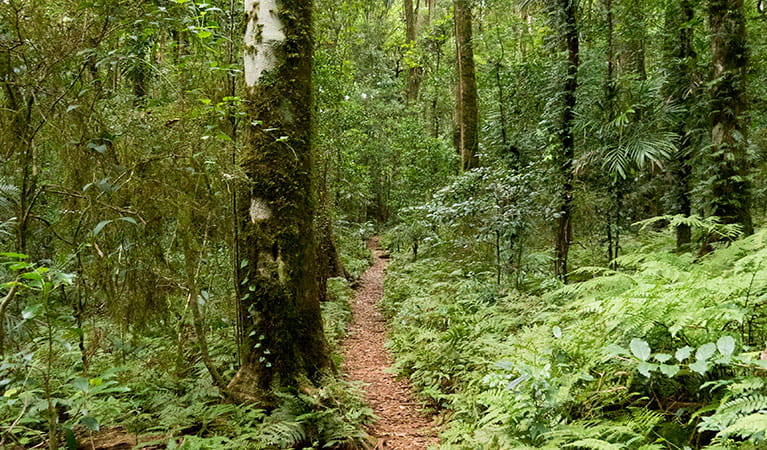Washpool National Park
Overview
Washpool National Park, north-west of Grafton or east of Glen Innes, offers wilderness walks, camping, and horse riding in stunning World Heritage surrounds.
Read more about Washpool National Park
Take time out to explore the unparalleled landscapes of Washpool National Park, a place of steep gorges, clear waters and magnificent tracts of ancient rainforest. You’ll find some of the most varied and least-disturbed forest in NSW, including the world’s largest stand of coachwood trees and extraordinary specimens of giant red cedar.
Washpool and adjacent Gibraltar Range National Park are part of the Gondwana Rainforests of Australia World Heritage Area, and offers wonderful wilderness walks lasting half an hour to several days, along with simple, miles-from-care camping and picnicking opportunities in gorgeous surrounds.
It’s also a natural haven for an incredible diversity of plants, mammals, amphibians, reptiles and birds, including some of Australia’s rarest and most unusual creatures, like the once thought to be extinct parma wallaby, the pouched frog, the long-nosed potoroo, and the beautiful, cat-like spotted-tailed quoll.
Birdwatchers will be in their element here – more than 140 species have been recorded, including the rufous scrub bird and the increasingly rare powerful owl.
Local alerts
For the latest updates on fires, closures and other alerts in this area, see https://www.nationalparks.nsw.gov.au/visit-a-park/parks/washpool-national-park/local-alerts
Map
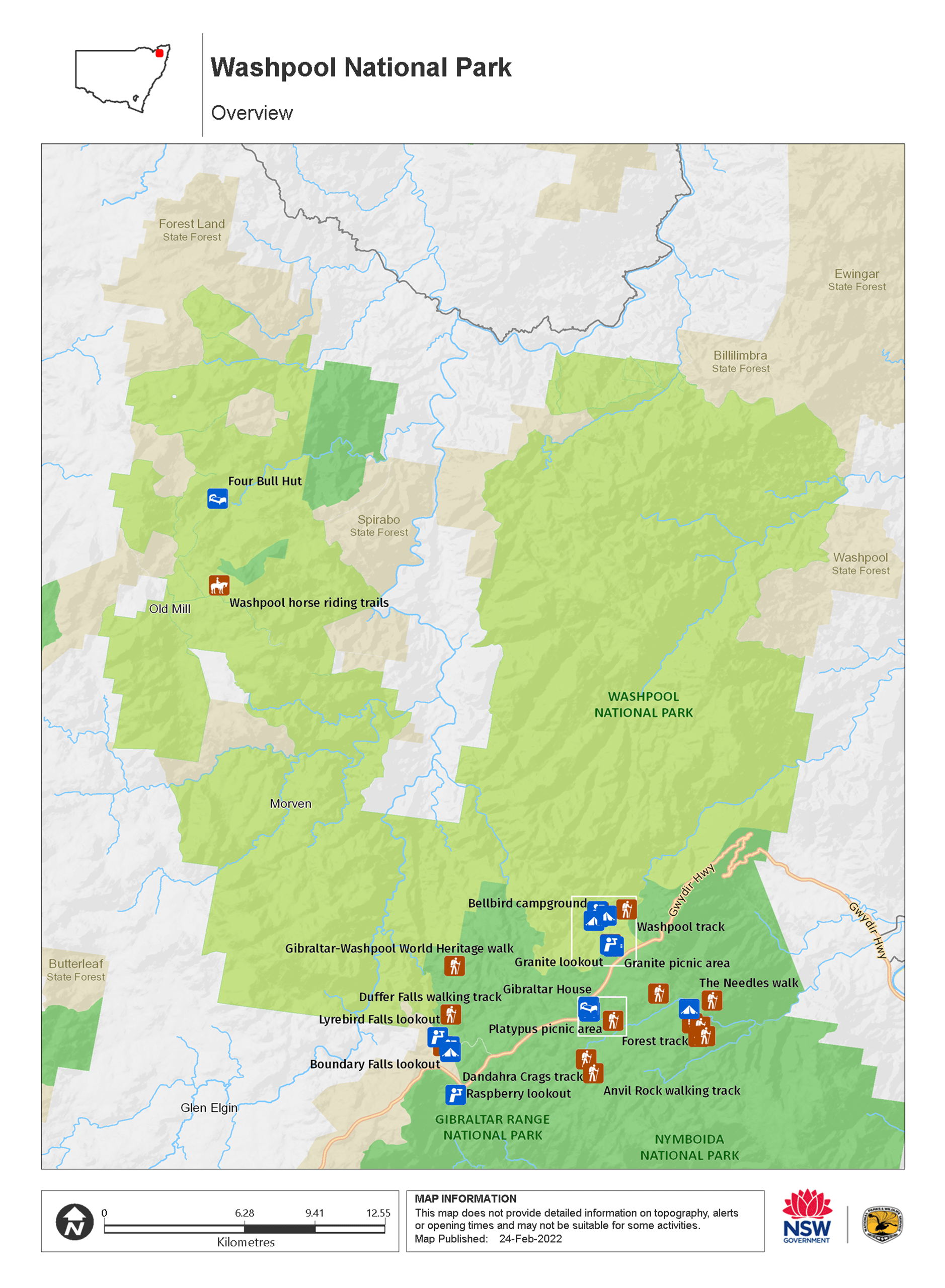
Map
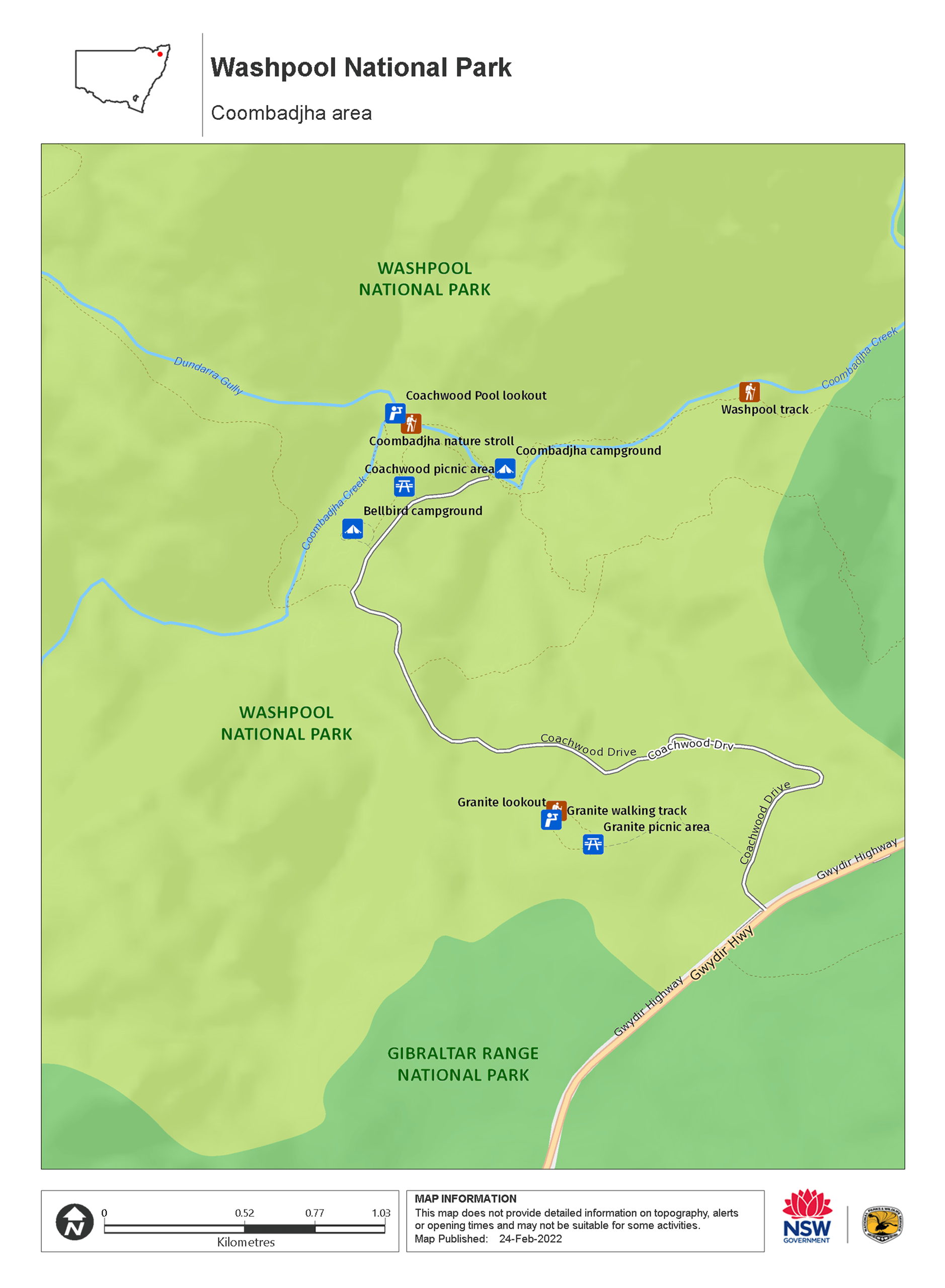
Map legend

Contact
- in the North Coast and Country NSW regions
Washpool National Park is always open but may have to close at times due to poor weather or fire danger.
-
Park entry fees:
$8 per vehicle per day applies only at attractions in the Glen Innes area. The park uses a self-registration fee collection system. Please bring the correct change and display your receipt.
Buy annual pass. -
-
Glen Innes office
02 6739 0700
Contact hours: Monday to Friday, 8.30am to 4.30pm. - 68 Church Street, Glen Innes NSW 2370
-
Email: npws.ntab@environment.nsw.gov.au
-
Glen Innes office
Visitor info
All the practical information you need to know about Washpool National Park.
Getting there and parking
Get driving directions
From Glen Innes, head east for around 78km and take the Coachwood Drive turnoff from the Gwydir Highway
From Grafton, head west for around 93km and take the Coachwood Drive turnoff from the Gwydir Highway
Parking
- Bellbird campground See on map
- Coachwood picnic area See on map
- Coombadjha campground See on map
- Granite picnic area See on map
By bike
Check out the Bicycle information for NSW website for more information.
Best times to visit
Washpool National Park offers an exceptional visit all year round. You're sure to find a walk, tour, activity or attraction to appeal, regardless of the season. Here are some of the highlights.
Autumn
Autumn offers good weather for exploring the park during the day and is cool enough during the evenings to sit by the campfire.
Spring
Mid-spring is a fantastic time to head out on the inspiring World Heritage walk. The temperature is perfect and the heathlands, swamps and woodlands erupt in a colourful display of wildflowers including the striking Gibraltar waratah.
Summer
Enjoy the shade of the rainforest with a picnic and walk, and then cool off with a dip in Coombajdha creek's natural pool.
Winter
The coldest time of the year means that you may likely have the park to yourself – enjoy the solitude.
Weather, temperature and rainfall
Summer temperature
Average
14°C and 26°C
Highest recorded
39.8°C
Winter temperature
Average
2°C and 15°C
Lowest recorded
-8.9°C
Rainfall
Wettest month
January
Driest month
April
The area’s highest recorded rainfall in one day
254.8mm
Facilities
Toilets
Picnic tables Show more
- Bellbird campground
- Coachwood picnic area
- Coombadjha campground
- Four Bull Hut
- Granite picnic area
- Washpool horse riding trails
Barbecue facilities Show more
Drinking water
Showers
Electric power
Maps and downloads
Fees and passes
Park entry fees:
$8 per vehicle per day applies only at attractions in the Glen Innes area. The park uses a self-registration fee collection system. Please bring the correct change and display your receipt.
- All Parks Pass - For all parks in NSW (including Kosciuszko NP) $190 (1 year) / $335 (2 years)
- Multi Parks Pass - For all parks in NSW (except Kosciuszko) $65 (1 year) / $115 (2 years)
- Country Parks Pass - For all parks in Country NSW (except Kosciuszko) $45 (1 year) / $75 (2 years)
- Single Country Park Pass - For entry to a single park in country NSW (except Kosciuszko). $22 (1 year) / $40 (2 years)
Annual passes and entry fees (https://www.nationalparks.nsw.gov.au/passes-and-fees)
Prohibited
Pets
Pets and domestic animals (other than certified assistance animals) are not permitted. Find out which regional parks allow dog walking and see the pets in parks policy for more information.
Smoking
NSW national parks are no smoking areas.
Nearby towns
Glen Innes (72 km)
Set in the most prolific sapphire region of Country NSW, Glen Innes hosts the annual Minerama Fossicking and Gem Show and the annual Australian Celtic Festival, and is home to the Australian Standing Stones.
Grafton (88 km)
Grafton is a gracious, historic city in the Clarence Valley farming district. It's situated on the broad Clarence River and surrounded by river flats.
Tenterfield (126 km)
Sir Henry Parkes delivered his famous "birth of our nation" speech in the Tenterfield School of Arts in 1889. His rousing speech is credited with being the decisive moment that set the country on its path toward Federation in 1901.
Learn more
Washpool National Park is a special place. Here are just some of the reasons why:
Walker's wonderland
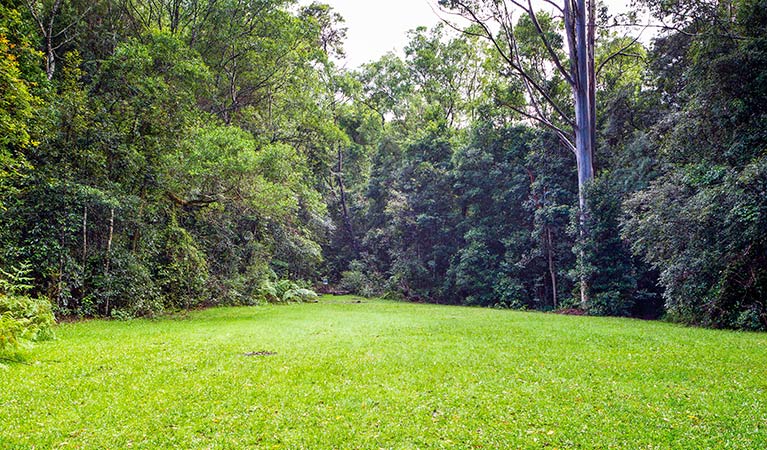
Lush rainforest, tinkling streams, dramatic gorges and an impressive plateau environment at just over the edge of the Great Escarpment make Washpool a singularly spectacular walking destination. Stretch your legs on an expansive network of graded walking tracks, including the popular World Heritage walk (which links Gibraltar Range and Washpool National Parks) and part of National trail. Nature strolls and the half-day Washpool walk commence from the creekside Coombadjha campground and take you on a meander through the lost world of the surrounding rainforest.
- Coachwood picnic area Enjoy a picnic surrounded by rainforest at Coachwood picnic area in Washpool National Park. It’s also the starting point for the Coombadjha nature stroll, a short walk.
- Granite picnic area Enjoy a picnic at Granite picnic area in Washpool National Park. Stretch your legs on an easy walk to Granite lookout for views over the World Heritage-listed landscape.
Rare residents
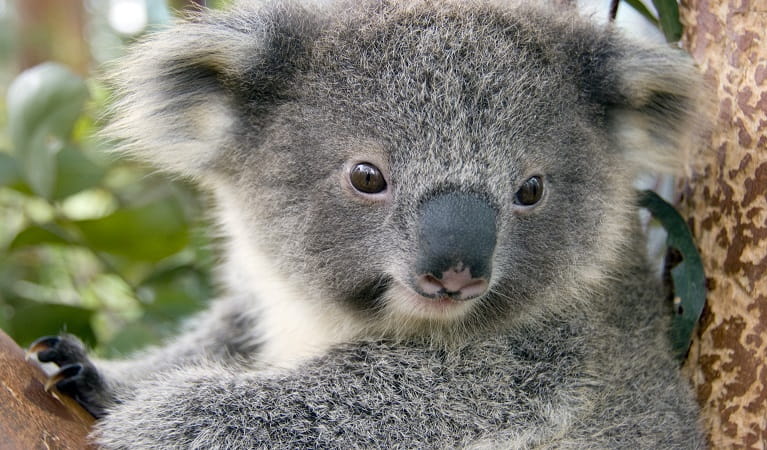
A huge range of threatened and endangered species enjoy the sanctuary of Washpool's diverse habitats. It's a refuge for mammals including koalas, spotted-tailed quolls, parma wallabies and long-nosed potoroos. Washpool and Gibraltar Range National Park are also brimming with birdlife. Look out for the rare rufous scrub bird in the rainforest undergrowth and, if you're extra vigilant, the even rarer powerful owl, which inhabits the hollows of trees in tall open forest. One of the most intriguing of the Washpool's residents is the pouched frog, a rainforest-dependent species whose male rears young tadpoles in pouches on his flanks.
- Coombadjha nature stroll Coombadjha nature stroll in Washpool National Park is a short yet inspiring walk through World Heritage listed rainforest, with a delightful swimming spot at the end.
- Washpool walking track Revel in the timeless wonder of ancient Gondwana Rainforest along Washpool walking track, and enjoy rare birdwatching and wildlife, in Washpool National Park, near Glen Innes.
Cultural connections
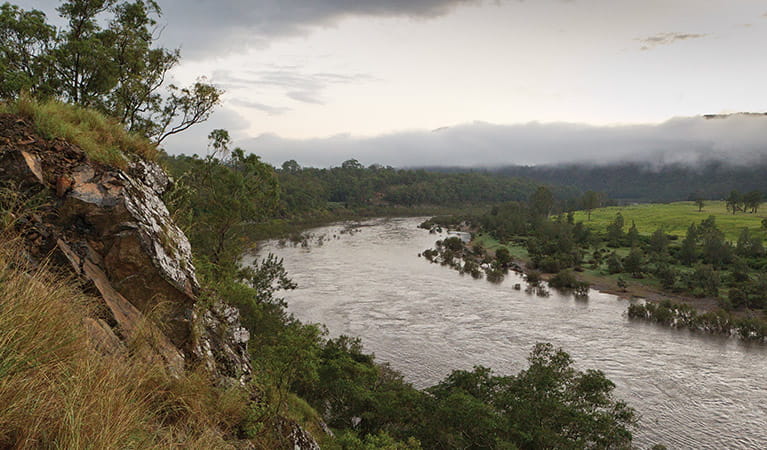
The Bundjalung, Ngarrabul and Gumbaingirri people have a long connection with the lands here; the area was once used as a route between the coast and the tablelands, and as a place to gather a range of resources, such as rainforest fruits.
An important legacy
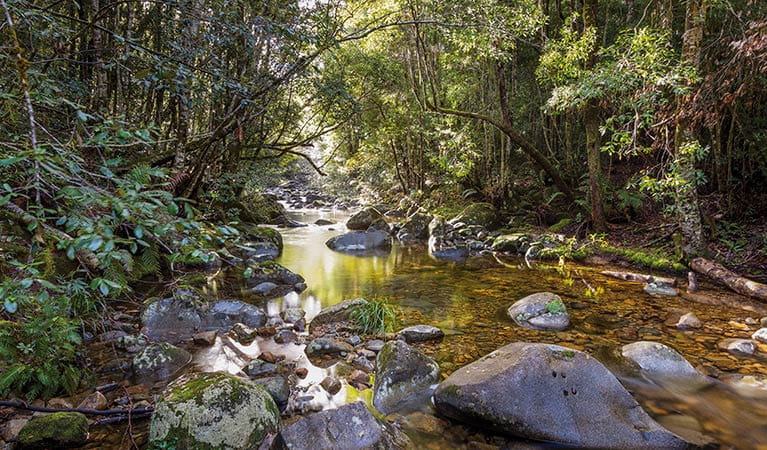
Washpool National Park is part of the Gondwana Rainforests of Australia World Heritage Area, which includes forty parks and reserves stretching along the Great Escarpment from Barrington Tops in NSW to south east Queensland. The area has a long history of selective logging, dating back to the 1800s when the valuable red cedar trees drew timber cutters with bullocks, axes and crosscut saws. With the development of machinery, the increasing pressure to exploit these forests met strong protest action from conservation groups. Ultimately, the park was created in 1983 after a study found the area contained significant plant and animal populations that either weren't found anywhere else in the state or were not well protected in reserves.
Plants and animals protected in this park
Animals
-

Swamp wallaby (Wallabia bicolor)
The swamp wallaby, also known as the black wallaby or black pademelon, lives in the dense understorey of rainforests, woodlands and dry sclerophyll forest along eastern Australia. This unique Australian macropod has a dark black-grey coat with a distinctive light-coloured cheek stripe.
-

Common ringtail possum (Pseudocheirus peregrinus)
Commonly found in forests, woodlands and leafy gardens across eastern NSW, the Australian ringtail possum is a tree-dwelling marsupial. With a powerful tail perfectly adapted to grasp objects, it forages in trees for eucalypt leaves, flowers and fruit.
-

Superb lyrebird (Menura novaehollandiae)
With a complex mimicking call and an elaborate courtship dance to match, the superb lyrebird is one of the most spectacular Australian animals. A bird watching must-see, the superb lyrebird can be found in rainforests and wet woodlands across eastern NSW and Victoria.
-

Southern boobook (Ninox novaeseelandiae)
The southern boobook, also known as the mopoke, is the smallest and most common native owl in Australia. With a musical 'boo-book' call that echoes through forests and woodlands, the southern boobook is a great one to look out for while bird watching.
Plants
-
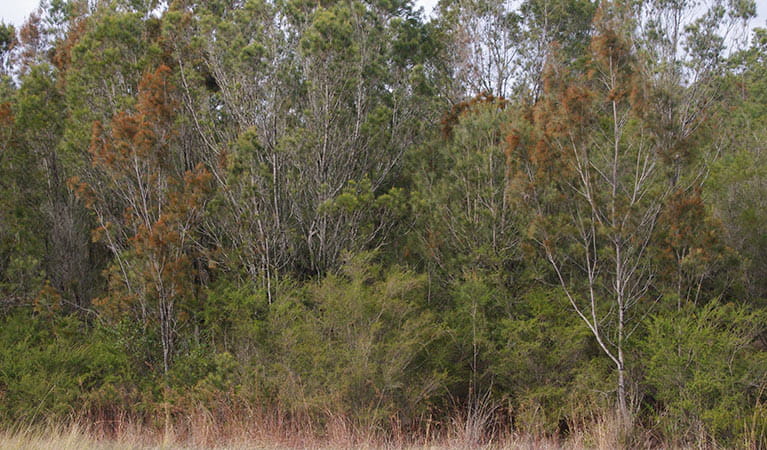
Black sheoak (Allocasuarina littoralis)
The black sheoak is one of a number of casuarina species found across the east coast of Australia and nearby tablelands. Growing to a height of 5-15m, these hardy Australian native plants can survive in poor or sandy soils. The barrel-shaped cone of the black sheoak grows to 10-30mm long.
Environments in this park
Education resources (1)
What we're doing
Washpool National Park has management strategies in place to protect and conserve the values of this park. Visit the OEH website for detailed park and fire management documents. Here is just some of the work we’re doing to conserve these values:
Managing weeds, pest animals and other threats
Pests and weeds have a significant impact to the ecosystems within Washpool National Park. NPWS carries out risk assesments for new and emerging weeds as well as wild dog control to protect biodiversity in this park.
Exploring World Heritage
NPWS strives to protect and conserve all NSW national parks, including Washpool National Park. Part of the Gondwana Rainforests of Australia World Heritage Area, this special park features a wealth of spectacular wilderness, the World Heritage values of which are painstakingly protected and preserved for the enjoyment of future generations.
Developing visitor facilities and experiences
Washpool National Park is committed to keeping its visitors safe and informed, and this extends to the matters of access and signage. Maintenance of park infrastructure, including directional signage and access points, is ongoing within this park.
Managing fire
NSW is one of the most bushfire prone areas in the world as a result of our climate, weather systems, vegetation and the rugged terrain. NPWS is committed to maintaining natural and cultural heritage values and minimising the likelihood and impact of bushfires via a strategic program of fire research, fire planning, hazard reduction, highly trained rapid response firefighting crews and community alerts.

